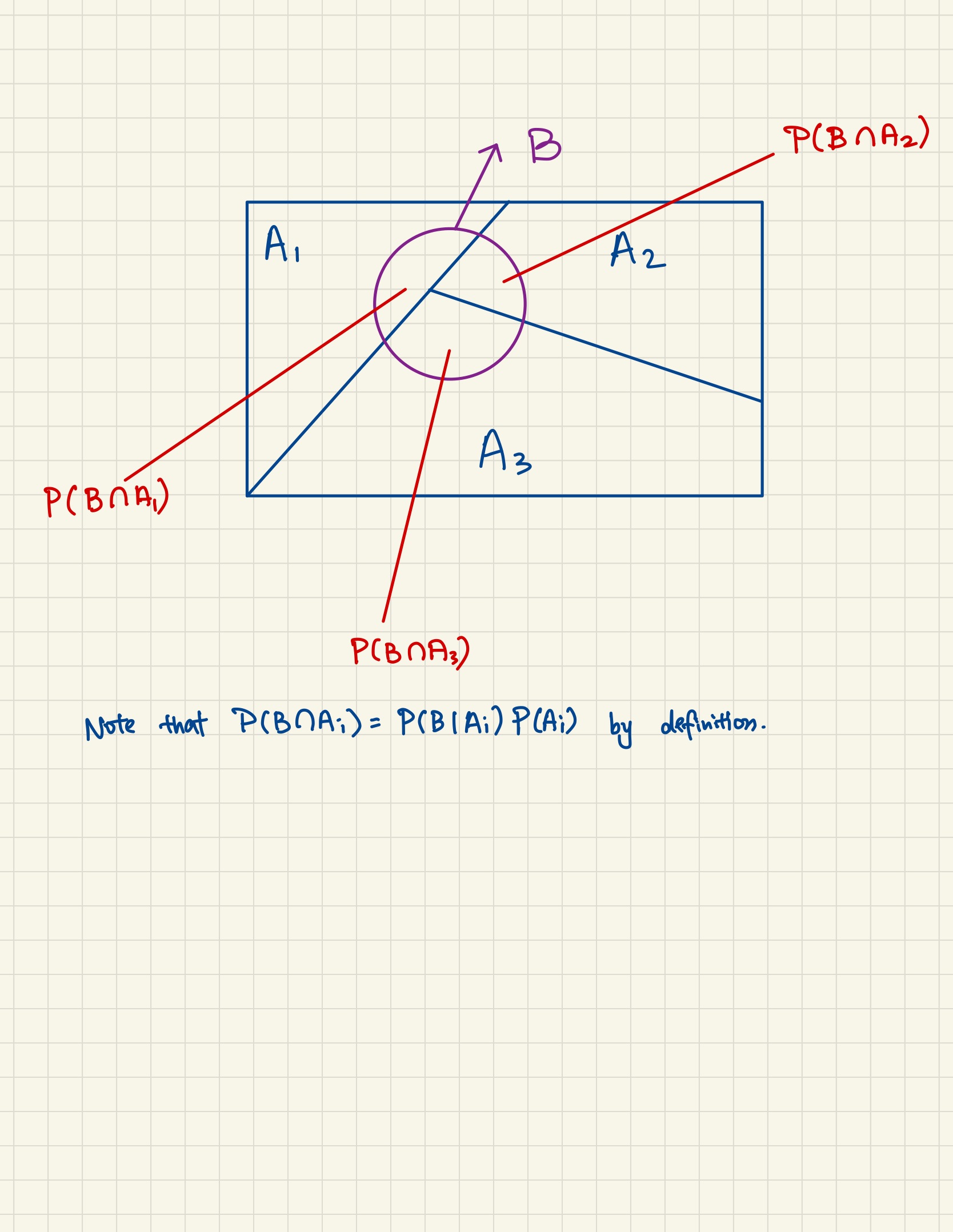Baye’s Theorem and the Law of Total Probability
Contents
Baye’s Theorem and the Law of Total Probability#
Baye’s Theorem#
Definition 13 (Baye’s Theorem)
Let \(\P\) be a probability function defined over the probability space \(\pspace\).
Two events \(A, B \in \E\) such that \(\P(A) > 0\) and \(\P(B) > 0\), we have
Proof. The observant reader should find it easy that this formula is deduced due to the fact that \(\P(A \cap B) = \P(B \cap A)\), and therefore
since \(\P(B ~|~ A) = \dfrac{\P(B \cap A)}{\P(A)}\).
Terminology (Posterior and Conditional Probability)#
From the proof of Baye’s Theorem, we see that there are two ways to view \(\P(A \cap B)\). If the context is clear, we may call \(\P(B|A)\) the conditional probability and \(\P(A|B)\) the posterior probability.
Law of Total Probability#
Theorem 3 (Law of Total Probability)
Let \(\P\) be a probability function defined over the probability space \(\pspace\).
Let \(\{A_1, \ldots, A_n\}\) be a partition of the sample space \(\S\). This means that \(A_1, \ldots, A_n\) are disjoint and \(\S = A_1 \cup \cdots \cup A_n\). Then, for any \(B \subseteq \S\), we have
Intuition and Interpretation (Law of Total Probability)#
The law of total probability can be stated more intuitively as the sum of event \(B\) and each of the disjoint event \(A_i\). We have to first recognize that the image below makes sense, assumming that the whole sample space can be made up of 3 disjoint events \(A_1, A_2, A_3\), and we see that event \(B\) touches all of them (i.e. there are overlaps), then it is obvious from the figure that \(\P(B)\) is the sum of \(\P(B \cap A_i)\). Note that event \(B\) does not necessarily need to touch all \(A_i\), if it doesn’t, then \(\P(B \cap A_i) = 0\).
Now if this intuition is established, we just express \(\P(B \cap A_i) = \P(B|A_i)\P(A_i)\) by conditional probability and we recovered back the formula for the law of total probability.

Fig. 4 Partition of Law of Total Probability.#
The intuition of this is also apparent after understanding that if a sample space can be broken down into disjoint events \(A_1, A_2, \ldots, A_k\), then any event \(B\) that is in the sample space must touch some of these disjoint events, whenever they overlap, we can represent them as \(\P(A_i \cap B)\), and if we add them up it is just the event \(B\) itself. If they don’t overlap, we can still add them anyways since \(P(A_k \cap B) = 0\). Note the loose usage of the index here, \(i\) means overlap, \(k\) means non-overlap.
Corollary 6 (Law of Total Probability (Corollary))
Let \(\{A_1, \ldots, A_n\}\) be a partition of the sample space \(\S\). This means that \(A_1, \ldots, A_n\) are disjoint and \(\S = A_1 \cup \cdots \cup A_n\). Then, for any \(B \subseteq \S\), we have
Exercise 2.47 {#exercise-247}#
Stanley H. Chan: Introduction to Probability for Data Science, 2021. (pp. 90-91)
Exercise 2.48 {#exercise-248}#
Stanley H. Chan: Introduction to Probability for Data Science, 2021. (pp. 91)
